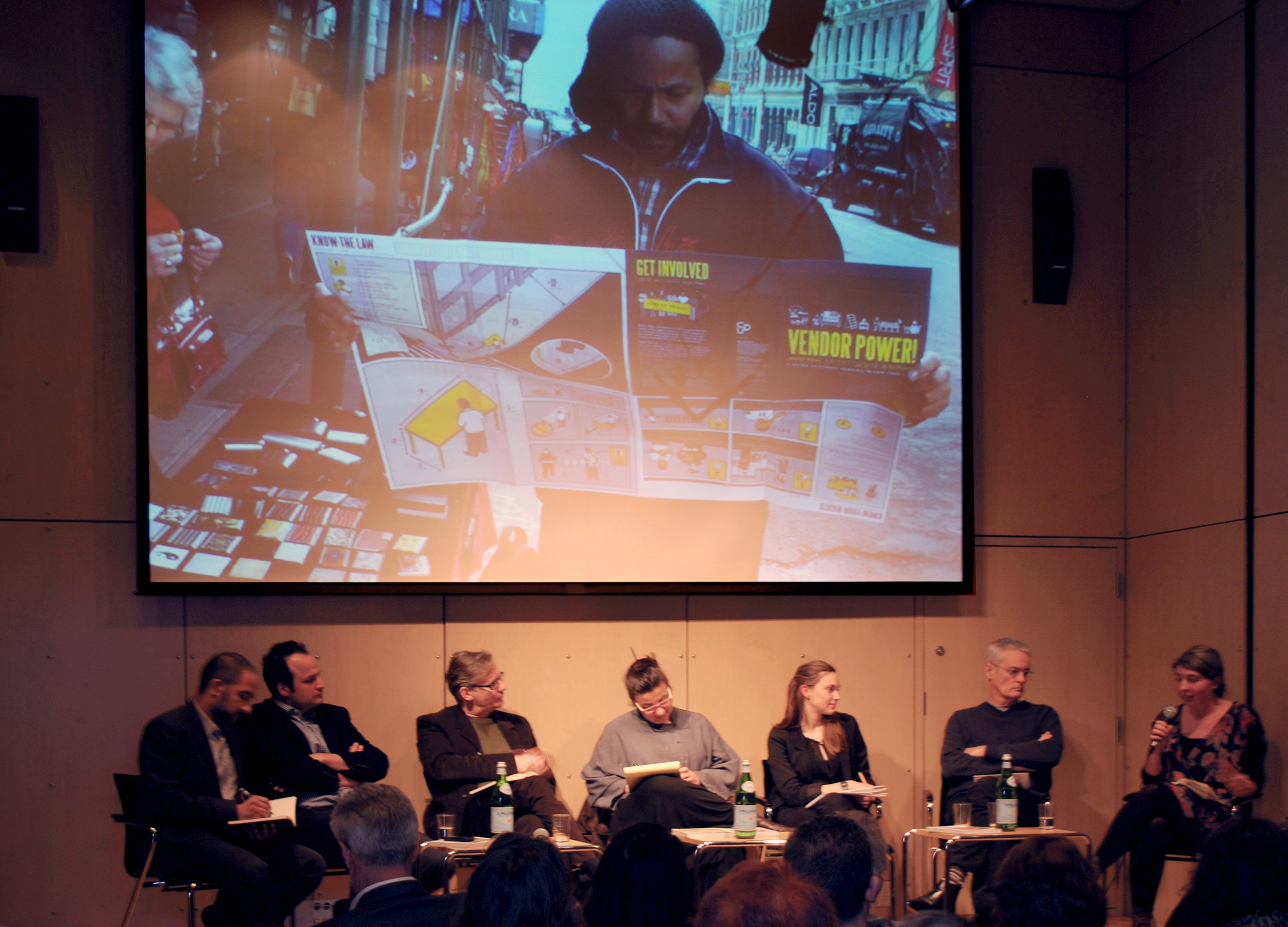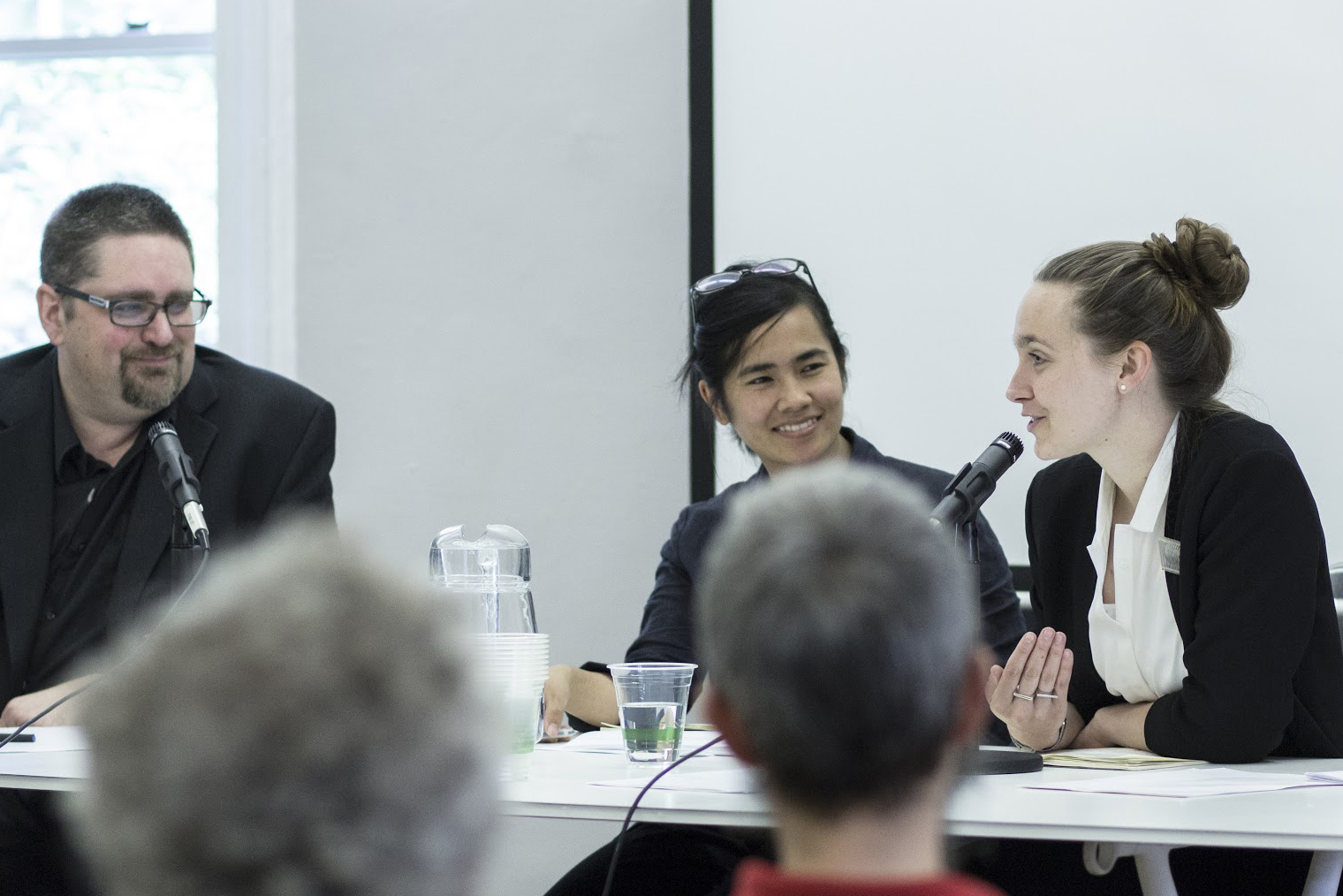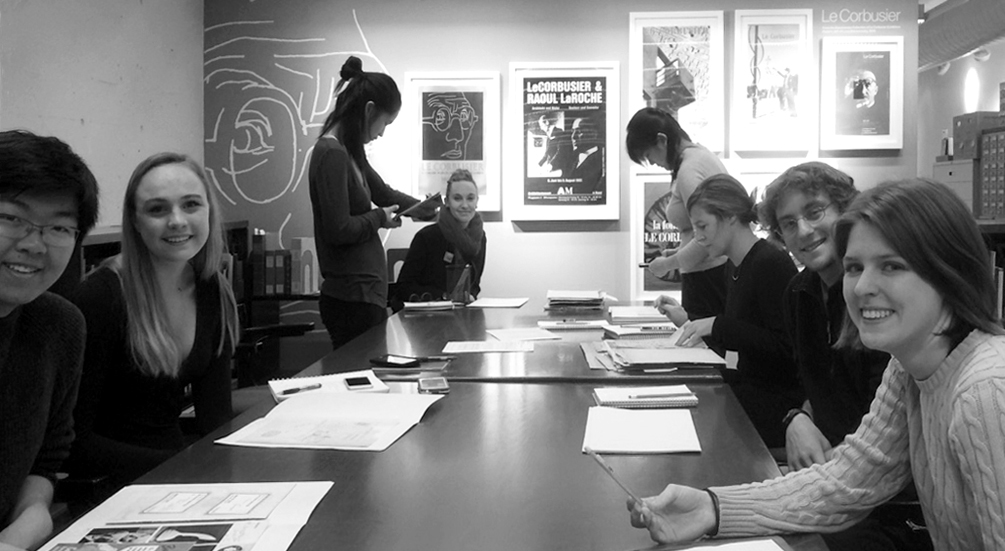Sisters, Architects: Laura and Sophie Hochhäusl on Sharing Knowledge and Engaging in Conversation
By Julia Gamolina, cover photo by Pia Clodi Both trained as architects, sisters Laura and Sophie Hochhäusl are now in distinctly different corners of the field. Sophie is an architectural historian - currently the Frieda L. Miller Fellow at the Radcliffe Institute of Advanced Studies at Harvard University, and appointed Assistant Professor at the University of Pennsylvania. Laura is a practicing architect in Austria; after working on architectural projects in Germany, Italy, and Brazil she has recently been appointed to be Principal and Partner of Hochhäusl & Moosbrugger Architekten in Salzburg. In this interview, they talk about their shared early experiences, their divergent paths, their current projects and their hopes for the future, advising young architects to be daring and to be proud of and steadfast about the value of their skills.
Though your focuses and interests in the field are quite different, what from your shared childhood do you think influenced you both to pursue paths in architecture?
L: We grew up in a household full of stories about architecture. Both of our parents were really involved in designing and building the environment in which we grew up, and always took us on trips to see the cities and buildings of Europe. One of the deep bonds as siblings derives from sharing – and contesting – the small space in the back of car during those vacations. We both have fond memories of the trips, but early on Sophie was drawn to narratives about urbanity, the history of cities, and modern life, whereas I remember the details and compositions of buildings we saw. These distinct interests grew more pronounced during the years when we studied architecture.
Despite your different paths, what do you share in the field?
S: I would say we share the larger idea of architecture as a social discipline, and both believe that the profession contributes to conversations on social justice and equality. We were both influenced by the works of the late Austrian economist and philosopher, Otto Neurath, whose goal was to illustrate social facts to diverse - and sometimes illiterate - audiences. In the 1920s and 1930s, these picture statistics had deep ramifications for the discipline of architecture and urbanism in illustrating socio-spatial relationships, and Laura and I were both fascinated by them.
The general climate at the Academy of Fine Arts, Vienna in the early 2000s was also formative for us. Some of Germany’s most influential theorists were teaching in the Art and Cultural Studies department at the University, among them Diedrich Diederichsen and Tom Holert, for whom Laura and I worked, and who really supported our careers. While the school remained committed to diversity in thought, many studios encouraged a fundamentally social agenda that conceived of design as more than mere building, and it has been important for me to have a sibling that shares some this background and these fundamental views about the profession and about life in general.
Both of you have lived and worked abroad. What have these experiences brought to your career?
L: Before working in architectural offices in Austria, I worked in Italy and conducted thesis research in Brazil. I conducted intensive analysis of housing development on site at the Favela Dona Marta in Rio de Janerio, as I was interested in resisting simplistic architectural dichotomies, such as perceived divisions between “planned” and “informal.” In favelas in the center of the city, houses may look “informal” but actually have high real-estate values due to tourism and land speculation. Learning about local ownership structures and building practices, and working on small-scale solutions that would have a tangible impact and could be implemented by people living on site, was important. We also designed green roofs that filter water and prevent the structures from overheating during summer, to give back green space. My experience in Brazil has sparked my interest in the entanglements of architecture, sustainability, and culture, and how property value can define the meaning of architecture.
S: As a scholar, it has been important for me to engage in on-going discourse on the history and theory of architecture, which is very strong in the United States. Having obtained my PhD in America, I have been really inspired by the collaborative and often interdisciplinary working methods encouraged at universities and research institutions. I have experienced great trust and confidence in collaborative research, and appreciate the usually non-hierarchical structures that are in place here.
What are some differences in the profession between Austria and the US?
L: One of the greatest differences between the United States and Austria is that the latter is a Welfare State, resulting in ramifications for almost every aspect of social life - health, education, and architecture as well. In architecture its impact is felt most deeply in housing. In particular, public and subsidized housing maintain exceptionally high standards in the quality of materials, assigned room sizes, exposure areas, and green space ratios per capita. In addition, most new housing in Austria is in some way subsidized and offers apartments for sale and rent in the same building. Because of its affordability, Vienna has now been elected the “most livable city in the world," with high satisfaction of tenants who live in public housing, and contentment with the quality of life among the population overall.
What are both of you currently working on?
L: At the moment, one of my favorite projects transforms an old mill into housing. We are clearly distinguishing the differences between the older existing structure and the new intervention; implementing modern architecture into a building that already has a history of its own is very exciting. I personally love the atmosphere and tension created with the old and the new.
S: Among various projects, I am currently working on an interdisciplinary architectural history and translation project titled Memories from Resistance: Women, War and the Forgotten Work of Margarete Schütte-Lihotzky. Alongside an in-depth discussion of the Austrian architect Schütte-Lihotzky’s design work, the project explores her engagement in the resistance movement against the Nazi regime and her postwar activism in the women’s and peace movements.
Today, Schütte-Lihotzky is mainly remembered for the design of her 1920s Frankfurt Kitchen and possibly her interwar work on housing. In this book, however, I want to highlight Schütte-Lihotzky’s wartime and post-war advocacy and her international professional networks with women - she was a housing advisor in Cuba and the president of the Austrian women’s movement from the 1960s onwards. I believe that telling a history about the entanglements of architecture and activism, and how architecture can have political agency, is very important.
What have been challenges that you’ve faced in your career?
S: The architectural profession today is obviously completely global and figuring out how to teach architectural history responsibly against this backdrop has been fascinating and exciting. The History of Art and Architecture Department at Boston University, where I taught previously, has implemented a number of geographic concentrations through which students can deepen their understanding of cities and buildings beyond standard periodization. In my own lecture courses, I remain true to this premise and highlight that architecture has always been in translation and that architectural knowledge has constantly been shared, has traveled, and has been in flux.
Who have been your mentors?
S: Having a good network of colleagues - that share everyday life, in whom one can confide, and with whom one can share successes and sometimes setbacks - is invaluable. Peer support was critical for me while writing my dissertation, in particular, with an all-female dissertation writing group. Also, having an accessible network of scholars who are further ahead in their careers, and who are able to give advice on all aspects of professional life, is critical. In this regard, in the United States, I have been extremely fortunate to be mentored by five women: my advisors, Felicity Scott, Sara Pritchard, and Alys George, who are scholars in architectural history, environmental history, and German Studies respectively, as well as architectural historians Mary Woods and Mary McLeod. When working with my own students, I try to maintain and impart the interdisciplinary outlook, the scholarly rigor, and the dedication and trust I have experienced in learning from these incredible scholars.
What still needs to be done for and by women in the field? How can we accomplish this?
L: Regarding equality both in professional and academic spheres, in some aspects we have come a long way, but numbers show, especially in regards to leadership and promotion, that much more can still be done. The first step in attaining equality, starting in school, is to train architecture students to be proud and steadfast about the value of their labor. Architects are highly specialized and combine knowledge in the realms of visuals, design, construction, and research. The ability to bring together a number of disciplines and fields of inquiry is extremely valuable and all architects should be proud of that.
S: I would second what Laura said and only add that this notion of equality of course needs to include, next to the strengthening and presence of women in architectural offices and academia, the rights of minorities and the LGBTQ community as well. Much can be done in this regard - the first step is to organize and to keep building institutions such as ArchiteXX, NOMA(S), the Architecture Lobby, and other dedicated groups such as the European History Network’s Gender Group.
There is also still continued need for conversation and scrutiny of the profession to address structural unevenness. Discussions should include equal pay for equal labor, but they also need to go beyond numbers, addressing legal frameworks, health and leave policies, and the conduct in every day work place environments, allowing us to achieve and exceed much needed parities. I also believe that women should support other women, and that our power derives from sharing information. If you want really want to be daring, ask a female and a male colleague of your trust about their salaries. You’d be surprised at what you hear.
What have been some highlights?
L: One critical experience for me was working at Studio Massimiliano & Doriana Fuksas in Rome. During this time, I was not only passed by some of the most iconic buildings in the world on my way to work, but I also gained insight into how large, corporate, global offices operate. I was fascinated by how a rough sketch from Massimiliano Fuksas would develop – with the engagement of a team of young architects from all over the world – into a plan, a section, a model, a detail and then a building on the other side of the world. The process of transformation, and observing how plans and sections become specific, is most exciting to me. In an office such as Studio Fuksas there is also the availability and accessibility of tools and experts in diverse areas, leading to a very rich experience for me as a young architect at the beginning of her career.
S: Working with students has been a highlight in the recent years. They surprise me on a daily basis and affirm my belief that knowledge of buildings, cities, and the past, matters.
What are you most proud of?
L: One of the most important achievements for me was the completion of a project at the office Berger Hofmann Architekten. The project was first conceived as a large hotel complex in the Austrian Alps. The main challenge became how to situate and contextualize the project within the relatively subtle, small-scale developments surrounding it. We ended up splitting the program into smaller cabins that blended more easily with rural housing typologies surrounding it and used ecologically conscious construction methods referencing the local vernacular building languages - the entire buildings are based on solid wood construction. I oversaw this project from the first designs through to its construction and opening, and the process remains a real highlight.
S: I have been happy about collaboration, both in my teaching and my research. One of the most exciting projects in this regard has been a relatively new “Architecture and Environment” group in the European Architectural History Network, which I have been co-organizing with my colleague Torsten Lange at the ETH Zurich - a group which includes more than 40 international scholars. Over the last months, we have hosted a number of conversations and have edited a joint paper pertaining to environmental questions in architectural history, with fifteen contributors. What has been most exciting is the formation of a distinct discourse about the environment, that moves beyond notions of sustainability and a “technological fix,” and seeks to theorize and historicize architecture in a broader context of resource histories.
Looking forward, what else would you still like to accomplish?
L: What every architect wants: to build a villa in Italy, win the Pritzker Prize, and have a historian write about me - preferably my sister! [laughs]
All kidding aside, I recently assumed the role of principal and partner of Hochhäusl & Moosbrugger Architekten, becoming Austria’s youngest independent female architect. Such a position is stimulating, but also sometimes challenging as the field is still dominated by men. However, I am very much looking forward to projects that lie ahead and hope to inspire and support other young architects.
S: Really, Julia, so much. In the long run, I would like to contribute to a larger debate on the architectural scholarship, the increased value of the humanities in a neo-liberal world, and the role of women within it. For the nearer future, I want to keep my eyes on book projects, specifically on Schütte-Lihotzky’s post-war architecture and activism. In addition, I want to keep engaging environmental questions, and the power of social and resistance movements, in architectural history. These themes have often intersected with women’s issues and I believe that all of these conversations are much needed today.
[author] [author_image timthumb='on']http://architexx.org/wp-content/uploads/2018/01/MA.jpg[/author_image] [author_info] With experience in design, business development, PR, and marketing, Julia Gamolina is focused on communicating identity in the built environment. She is a regular contributor to sub_texxt, interviewing women in architecture on their career development. She is also on the Young Leader's Group committee for the Urban Land Institute (ULI), and is a Founding Member of the Wing. Julia received her Bachelor of Architecture at Cornell University, graduating with the Charles Goodwin Sands Memorial Medal for exceptional merit in the thesis of architecture.[/author_info] [/author]









